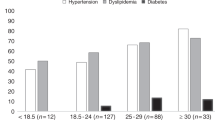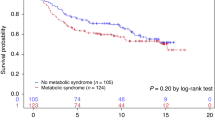Abstract
We conducted a cross-sectional study to estimate the prevalence of metabolic syndrome, a clustering of risk factors associated with cardiovascular disease, among 86 adults who had allogeneic hematopoietic-cell transplant (HCT) as compared with 258 age- and gender-matched US population controls selected from the 2005–2006 National Health and Nutrition Examination Survey database. The median age at study enrollment was 50 years (range, 21–71), and patients were at a median of 3 years (range, 1–21) from HCT. The prevalence of metabolic syndrome was 49% (95% confidence intervals (CI), 38–60%) among HCT recipients, a 2.2-fold (95% CI, 1.3–3.6, P=0.002) increase compared with controls. The prevalence rates of elevated blood pressure and hypertriglyceridemia were significantly higher among HCT recipients than among controls, but the prevalence rates of abdominal obesity, elevated blood glucose and low high-density lipoprotein cholesterol were not. HCT survivors with metabolic syndrome were more likely to have microalbuminuria (43 vs 10%) and elevated creatinine (31 vs 11%). No patient, donor or transplant characteristics were associated with the diagnosis of metabolic syndrome. We conclude that metabolic syndrome occurs frequently among allogeneic HCT survivors who are seen by transplant physicians. Approaches to screening, prevention and management of metabolic syndrome should be developed for HCT recipients.
This is a preview of subscription content, access via your institution
Access options
Subscribe to this journal
Receive 12 print issues and online access
$259.00 per year
only $21.58 per issue
Buy this article
- Purchase on Springer Link
- Instant access to full article PDF
Prices may be subject to local taxes which are calculated during checkout
Similar content being viewed by others
References
National Cholesterol Education Program (NCEP) Expert Panel on Detection, Evaluation, and Treatment of High Blood Cholesterol in Adults (Adult Treatment Panel III). Third Report of the National Cholesterol Education Program (NCEP) Expert Panel on Detection, Evaluation, and Treatment of High Blood Cholesterol in Adults (Adult Treatment Panel III) final report. Circulation 2002; 106: 3143–3421.
Grundy SM, Brewer Jr HB, Cleeman JI, Smith Jr SC, Lenfant C . Definition of metabolic syndrome: report of the National Heart, Lung, and Blood Institute/American Heart Association conference on scientific issues related to definition. Circulation 2004; 109: 433–438.
Grundy SM, Hansen B, Smith Jr SC, Cleeman JI, Kahn RA . Clinical management of metabolic syndrome: report of the American Heart Association/National Heart, Lung, and Blood Institute/American Diabetes Association conference on scientific issues related to management. Circulation 2004; 109: 551–556.
Kahn R, Buse J, Ferrannini E, Stern M . The metabolic syndrome: time for a critical appraisal: joint statement from the American Diabetes Association and the European Association for the Study of Diabetes. Diabetes Care 2005; 28: 2289–2304.
Ford ES, Giles WH, Dietz WH . Prevalence of the metabolic syndrome among US adults: findings from the third National Health and Nutrition Examination Survey. JAMA 2002; 287: 356–359.
Ford ES, Giles WH, Mokdad AH . Increasing prevalence of the metabolic syndrome among US adults. Diabetes care 2004; 27: 2444–2449.
Grundy SM, Cleeman JI, Daniels SR, Donato KA, Eckel RH, Franklin BA et al. Diagnosis and management of the metabolic syndrome: an American Heart Association/National Heart, Lung, and Blood Institute Scientific Statement. Circulation 2005; 112: 2735–2752.
Nuver J, Smit AJ, Postma A, Sleijfer DT, Gietema JA . The metabolic syndrome in long-term cancer survivors, an important target for secondary preventive measures. Cancer Treat Rev 2002; 28: 195–214.
Nuver J, Smit AJ, Wolffenbuttel BH, Sluiter WJ, Hoekstra HJ, Sleijfer DT et al. The metabolic syndrome and disturbances in hormone levels in long-term survivors of disseminated testicular cancer. J Clin Oncol 2005; 23: 3718–3725.
Neville KA, Cohn RJ, Steinbeck KS, Johnston K, Walker JL . Hyperinsulinemia, impaired glucose tolerance and diabetes mellitus in survivors of childhood cancer: prevalence and risk factors. J Clin Endocrinol Metab 2006; 91: 4401–4407.
Ness KK, Oakes JM, Punyko JA, Baker KS, Gurney JG . Prevalence of the metabolic syndrome in relation to self-reported cancer history. Ann Epidemiol 2005; 15: 202–206.
Meinardi MT, Gietema JA, van der Graaf WT, van Veldhuisen DJ, Runne MA, Sluiter WJ et al. Cardiovascular morbidity in long-term survivors of metastatic testicular cancer. J Clin Oncol 2000; 18: 1725–1732.
Gurney JG, Ness KK, Sibley SD, O'Leary M, Dengel DR, Lee JM et al. Metabolic syndrome and growth hormone deficiency in adult survivors of childhood acute lymphoblastic leukemia. Cancer 2006; 107: 1303–1312.
Swerdlow AJ, Higgins CD, Smith P, Cunningham D, Hancock BW, Horwich A et al. Myocardial infarction mortality risk after treatment for Hodgkin disease: a collaborative British cohort study. J Natl Cancer Inst 2007; 99: 206–214.
Taskinen M, Saarinen-Pihkala UM, Hovi L, Lipsanen-Nyman M . Impaired glucose tolerance and dyslipidaemia as late effects after bone-marrow transplantation in childhood. Lancet 2000; 356: 993–997.
Baker KS, Ness KK, Steinberger J, Carter A, Francisco L, Burns LJ et al. Diabetes, hypertension, and cardiovascular events in survivors of hematopoietic cell transplantation: a report from the bone marrow transplantation survivor study. Blood 2007; 109: 1765–1772.
Tichelli A, Bhatia S, Socie G . Cardiac and cardiovascular consequences after haematopoietic stem cell transplantation. Br J Haematol 2008; 142: 11–26.
Tichelli A, Bucher C, Rovo A, Stussi G, Stern M, Paulussen M et al. Premature cardiovascular disease after allogeneic hematopoietic stem-cell transplantation. Blood 2007; 110: 3463–3471.
Annaloro C, Usardi P, Airaghi L, Giunta V, Forti S, Orsatti A et al. Prevalence of metabolic syndrome in long-term survivors of hematopoietic stem cell transplantation. Bone Marrow Transplant 2008; 41: 797–804.
Centers for Disease Control and Prevention (CDC). National Center for Health Statistics (NCHS). National Health and Nutrition Examination Survey Questionnaire. U.S. Department of Health and Human Services, Centers for Disease Control and Prevention: Hyattsville, MD, 2005–2006 [http://www.cdc.gov/nchs/about/major/nhanes/nhanes2005-2006/nhanes05_06.htm].
Lorini R, Cortona L, Scaramuzza A, De Stefano P, Locatelli F, Bonetti F et al. Hyperinsulinemia in children and adolescents after bone marrow transplantation. Bone Marrow Transplant 1995; 15: 873–877.
Walker BR . Glucocorticoids and cardiovascular disease. Eur J Endocrinol 2007; 157: 545–559.
Crutchlow MF, Bloom RD . Transplant-associated hyperglycemia: a new look at an old problem. Clin J Am Soc Nephrol 2007; 2: 343–355.
Faenza A, Fuga G, Nardo B, Donati G, Cianciolo G, Scolari MP et al. Metabolic syndrome after kidney transplantation. Transplant Proc 2007; 39: 1843–1846.
Courivaud C, Kazory A, Simula-Faivre D, Chalopin JM, Ducloux D . Metabolic syndrome and atherosclerotic events in renal transplant recipients. Transplantation 2007; 83: 1577–1581.
Cordero Fort A, Gavira JJ, Alegria-Barrero E, Castano S, Martin A, Ubilla M et al. Prevalence of metabolic syndrome in heart transplant patients: role of previous cardiopathy and years since the procedure--the TRACA study. J Heart Lung Transplant 2006; 25: 1192–1198.
Augustine JJ, Hricik DE . Steroid sparing in kidney transplantation: changing paradigms, improving outcomes, and remaining questions. Clin J Am Soc Nephrol 2006; 1: 1080–1089.
Rike AH, Mogilishetty G, Alloway RR, Succop P, Roy-Chaudhury P, Cardi M et al. Cardiovascular risk, cardiovascular events, and metabolic syndrome in renal transplantation: comparison of early steroid withdrawal and chronic steroids. Clin Transplant 2008; 22: 229–235.
Jaber JJ, Feustel PJ, Elbahloul O, Conti AD, Gallichio MH, Conti DJ . Early steroid withdrawal therapy in renal transplant recipients: a steroid-free sirolimus and CellCept-based calcineurin inhibitor-minimization protocol. Clin Transplant 2007; 21: 101–109.
Rutter MK, Meigs JB, Sullivan LM, D'Agostino Sr RB, Wilson PW . C-reactive protein, the metabolic syndrome, and prediction of cardiovascular events in the Framingham Offspring Study. Circulation 2004; 110: 380–385.
Tauchmanova L, Matarese G, Carella C, De Rosa G, Serio B, Ricci P et al. High serum leptin in patients with chronic graft-versus-host disease after hematopoietic stem cell transplantation. Transplantation 2004; 78: 1376–1383.
Walker SA, Riches PG, Rogers TR, White S, Hobbs JR . Value of serum C-reactive protein measurement in the management of bone marrow transplant recipients. Part II: Late post-transplant period. J Clin Pathol 1984; 37: 1022–1026.
Chen J, Muntner P, Hamm LL, Jones DW, Batuman V, Fonseca V et al. The metabolic syndrome and chronic kidney disease in U.S. adults. Ann Int Med 2004; 140: 167–174.
Wahba IM, Mak RH . Obesity and obesity-initiated metabolic syndrome: mechanistic links to chronic kidney disease. Clin J Am Soc Nephrol 2007; 2: 550–562.
Acknowledgements
We gratefully acknowledge all patients who participated in this study. We thank Carina Moravec, ARNP, for her assistance in completing the case report forms of study participants at the Fred Hutchinson Cancer Research Center/Seattle Cancer Care Alliance. This study was supported in part by grant CA15704 from the National Institutes of Health (NIH), Bethesda, MD, USA.
Author information
Authors and Affiliations
Corresponding author
Rights and permissions
About this article
Cite this article
Majhail, N., Flowers, M., Ness, K. et al. High prevalence of metabolic syndrome after allogeneic hematopoietic cell transplantation. Bone Marrow Transplant 43, 49–54 (2009). https://doi.org/10.1038/bmt.2008.263
Received:
Revised:
Accepted:
Published:
Issue Date:
DOI: https://doi.org/10.1038/bmt.2008.263
Keywords
This article is cited by
-
The European Society for Blood and Marrow Transplantation (EBMT) roadmap and perspectives to improve nutritional care in patients undergoing hematopoietic stem cell transplantation on behalf of the Cellular Therapy and Immunobiology Working Party (CTIWP) and the Nurses Group (NG) of the EBMT
Bone Marrow Transplantation (2023)
-
Selection bias in follow-up studies of stem cell transplantation survivors: an experience within the Maastricht Observational study of late effects after Stem cell trAnsplantation (MOSA)
Annals of Hematology (2023)
-
Heart Transplant, Kawasaki Disease, and Bone Marrow Transplant: Are There Consequences?
Current Atherosclerosis Reports (2022)
-
Prevalence of untreated and uncontrolled cardiovascular risk factors in survivors of allogeneic cell transplantation
Bone Marrow Transplantation (2021)
-
Early signs of metabolic syndrome in pediatric central nervous system tumor survivors after high-dose chemotherapy and autologous stem-cell transplantation and radiation
Child's Nervous System (2021)



